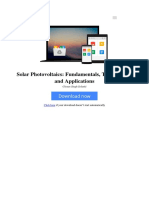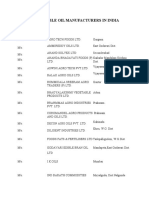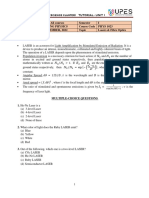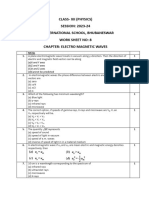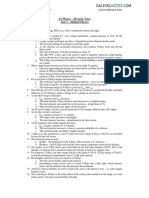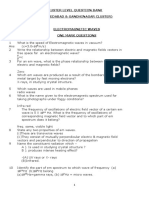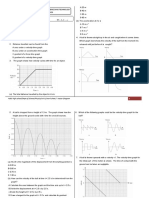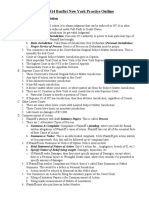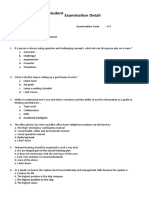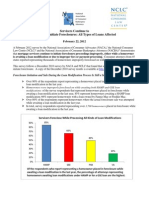0 ratings0% found this document useful (0 votes)
81 viewsWorksheet 2 Waves
Worksheet 2 Waves
Uploaded by
DhanBahadurThis document contains information about waves, including:
1) A radio station broadcasting at 198 kHz, with a longer wavelength making it less impacted by obstacles than shorter wavelengths.
2) Ultrasound used in medicine at 4.5 MHz to image inside the body without surgery, calculating a reflecting surface is 1.2 cm below the skin.
3) Polarized light from ice and how polarized sunglasses reduce reflected light entering the eyes.
Copyright:
© All Rights Reserved
Available Formats
Download as DOCX, PDF, TXT or read online from Scribd
Worksheet 2 Waves
Worksheet 2 Waves
Uploaded by
DhanBahadur0 ratings0% found this document useful (0 votes)
81 views1 pageThis document contains information about waves, including:
1) A radio station broadcasting at 198 kHz, with a longer wavelength making it less impacted by obstacles than shorter wavelengths.
2) Ultrasound used in medicine at 4.5 MHz to image inside the body without surgery, calculating a reflecting surface is 1.2 cm below the skin.
3) Polarized light from ice and how polarized sunglasses reduce reflected light entering the eyes.
Original Description:
waves
Copyright
© © All Rights Reserved
Available Formats
DOCX, PDF, TXT or read online from Scribd
Share this document
Did you find this document useful?
Is this content inappropriate?
This document contains information about waves, including:
1) A radio station broadcasting at 198 kHz, with a longer wavelength making it less impacted by obstacles than shorter wavelengths.
2) Ultrasound used in medicine at 4.5 MHz to image inside the body without surgery, calculating a reflecting surface is 1.2 cm below the skin.
3) Polarized light from ice and how polarized sunglasses reduce reflected light entering the eyes.
Copyright:
© All Rights Reserved
Available Formats
Download as DOCX, PDF, TXT or read online from Scribd
Download as docx, pdf, or txt
0 ratings0% found this document useful (0 votes)
81 views1 pageWorksheet 2 Waves
Worksheet 2 Waves
Uploaded by
DhanBahadurThis document contains information about waves, including:
1) A radio station broadcasting at 198 kHz, with a longer wavelength making it less impacted by obstacles than shorter wavelengths.
2) Ultrasound used in medicine at 4.5 MHz to image inside the body without surgery, calculating a reflecting surface is 1.2 cm below the skin.
3) Polarized light from ice and how polarized sunglasses reduce reflected light entering the eyes.
Copyright:
© All Rights Reserved
Available Formats
Download as DOCX, PDF, TXT or read online from Scribd
Download as docx, pdf, or txt
You are on page 1of 1
DEPARTMENT OF SCIENCE
Addu High School PHYSICS
Hithadhoo/Addu
Worksheet 2- Waves
1. A radio station broadcasts at a frequency of 198 kHz.
(a) Calculate the wavelength of these radio waves.
(b) Obstacles such as buildings and hills can make it difficult to receive some radio signals with
shorter wavelengths. Explain why this is less of a problem for this radio station.
2. Ultrasound scanning can be used by doctors to obtain information about the internal structures of
the human body without the need for surgery. Pulses of ultrasound are sent into the body from a
transmitter placed on the skin.
(i) The ultrasound used has a frequency of 4.5 MHz. State why waves of this frequency are
called ultrasound.
(ii) A pulse of ultrasound enters the body and its reflection returns to the transmitter after a
total time of 1.6 x 104 calculate how far the reflecting surface is below the skin.
average speed of ultrasound in the body = 1500 m s1.
(iii) State why the ultrasound is transmitted in pulses.
(iv) Another way of obtaining information about the internal structures of the human body is by
the use of X-rays. Give one property of X-rays which makes them more hazardous to use
than ultrasound.
(v) State two other differences between X-rays and ultrasound.
3. (a) Light from the Sun is unpolarised. Explain what is meant by unpolarised.
(b) When a ray of light from the Sun is incident on a block of ice, most of the light is refracted into
the ice. Some of it is reflected. The light that is reflected is partially plane polarised. Describe a
test to confirm that the reflected ray is partially plane polarised
(c) Some skiers wear sunglasses with polarising lenses. These sunglasses reduce the amount of
reflected light entering their eyes. Suggest how these sunglasses work.
4. A diagram shows the structure of a compact disc.
A laser light beam is directed at right angles to
the underside of the disc.
The wavelength of the laser light in the
transparent plastic layer is 414 nm
refractive index of the transparent plastic layer =
1.53
(a) Calculate the wavelength of the light in air.
(b) Light reflected from point A is 180q out of
phase with light reflected from point B. Calculate the minimum vertical distance from A to B.
(c) Explain the effect when the light reflected from A and B is combined.
(d) Some of the reflected light will not hit the plastic-air boundary at 90q.
Calculate the critical angle of the plastic-air boundary
(e) On the diagram below, show what
happens to a ray of light which hits the
plastic-air boundary at point P at an
angle greater than the critical angle.
Addu high school/Dept of Science/Physics/unit 2/work sheet 2/ waves.
You might also like
- Solar Photovoltaics Fundamentals Technologies and Applications by Chetan Singh Solanki 8120343867 PDFDocument5 pagesSolar Photovoltaics Fundamentals Technologies and Applications by Chetan Singh Solanki 8120343867 PDFSaurav Suman14% (7)
- List of All Edible Oil ManufacturersDocument18 pagesList of All Edible Oil ManufacturersUday kumar50% (2)
- (CIE Teacher Support) A2 Level - Common Questions On Medical Physics & TelecommunicationsDocument8 pages(CIE Teacher Support) A2 Level - Common Questions On Medical Physics & TelecommunicationsjohnNo ratings yet
- 14 Worksheet (AS) : 1 The Diagram Shows A Graph of The Displacement of A WaveDocument4 pages14 Worksheet (AS) : 1 The Diagram Shows A Graph of The Displacement of A WaveNolawitNo ratings yet
- Physics Chapter 24 AnswersDocument11 pagesPhysics Chapter 24 AnswersKarissaNo ratings yet
- Linguistics & PhilologyDocument11 pagesLinguistics & PhilologyH Janardan Prabhu100% (1)
- Border Geography PrintDocument12 pagesBorder Geography PrintMahnoor ParachaNo ratings yet
- Worksheet 2 WavesDocument1 pageWorksheet 2 WavesDhanBahadurNo ratings yet
- As Unit-2 Student Book (QuestionDocument15 pagesAs Unit-2 Student Book (QuestionCostas Paschalides100% (2)
- Physics (OL1) (3rd) Dec2017Document1 pagePhysics (OL1) (3rd) Dec2017AmitNo ratings yet
- 978 0 7978 0205 6.4 - SampleDocument9 pages978 0 7978 0205 6.4 - SampleJagdeep ArryNo ratings yet
- X-Rays: 14 An X-Ray Beam of Initial Intensity 50 W MDocument5 pagesX-Rays: 14 An X-Ray Beam of Initial Intensity 50 W MCarlos KasambiraNo ratings yet
- Physics IiDocument4 pagesPhysics IiNtirnyuy LeenaNo ratings yet
- HL Paper 3: Do Not Accept Answers Based On "X-Rays Are Harmful"Document39 pagesHL Paper 3: Do Not Accept Answers Based On "X-Rays Are Harmful"Fake AccountNo ratings yet
- Physics Dept. (Applied Science Cluster) TUTORIAL - UNIT 1Document5 pagesPhysics Dept. (Applied Science Cluster) TUTORIAL - UNIT 1Prince JunejaNo ratings yet
- Ec405 Module 1Document46 pagesEc405 Module 1Study With MeNo ratings yet
- Waves and Sound WorksheetDocument12 pagesWaves and Sound WorksheetprosenNo ratings yet
- PHY Wave OpticsDocument3 pagesPHY Wave Opticsakshanshverma9870No ratings yet
- Waves and Sound WorksheetDocument11 pagesWaves and Sound Worksheetsmartamjad90% (20)
- CBSE Physics (Chapter Wise With Hint / Solution) Class XII: Communications Systems KeyDocument3 pagesCBSE Physics (Chapter Wise With Hint / Solution) Class XII: Communications Systems KeySubhojyotiDasNo ratings yet
- 12 Physics WS Chapter 8 Emw QP 2023-24Document4 pages12 Physics WS Chapter 8 Emw QP 2023-24Bhumika MahantaNo ratings yet
- SL Paper 3: One Example of How Fibre Optic Technology Has Impacted SocietyDocument60 pagesSL Paper 3: One Example of How Fibre Optic Technology Has Impacted SocietyFake AccountNo ratings yet
- CH 8Document12 pagesCH 8terasaini77No ratings yet
- Ch8 - Electromagnetic WavesDocument23 pagesCh8 - Electromagnetic Wavesparthahuja296No ratings yet
- Exercises: Section 32.2 Plane Electromagnetic Waves and The Speed of LightDocument3 pagesExercises: Section 32.2 Plane Electromagnetic Waves and The Speed of LightCyn SyjucoNo ratings yet
- Mock 3 Exam (IG-Jan 24, Physics)Document19 pagesMock 3 Exam (IG-Jan 24, Physics)manawthukha paingsoeNo ratings yet
- Chapter19pp171 180 PDFDocument10 pagesChapter19pp171 180 PDFInderMahesh0% (1)
- AS Physics - Revision Notes Unit 3 - Medical PhysicsDocument3 pagesAS Physics - Revision Notes Unit 3 - Medical PhysicsIsrafil TamimNo ratings yet
- Minimum Learning Material (XII)Document6 pagesMinimum Learning Material (XII)Abhi VarnaNo ratings yet
- CLASS XII Physics Preboard Term 2 FinalDocument4 pagesCLASS XII Physics Preboard Term 2 FinalParth SharmaNo ratings yet
- Edexcel A-LEVEL PHY4 January 2003 QPDocument2 pagesEdexcel A-LEVEL PHY4 January 2003 QPapi-3726022No ratings yet
- Physics Sound and WavesDocument11 pagesPhysics Sound and WavesCraft CityNo ratings yet
- Problems Based On Space Weather and Space RadiationsDocument5 pagesProblems Based On Space Weather and Space RadiationsAnurag RanaNo ratings yet
- HL Paper3Document20 pagesHL Paper3Fake AccountNo ratings yet
- Physics II Problems PDFDocument1 pagePhysics II Problems PDFBOSS BOSSNo ratings yet
- Chem 406: Biophysical Chemistry Lecture 7: Structure Determination by X-Ray CrystallographyDocument11 pagesChem 406: Biophysical Chemistry Lecture 7: Structure Determination by X-Ray CrystallographyPuspa BhattaraiNo ratings yet
- Unit-5 Topic-7 Astrophysics and Cosmology Answers (End-Of-Chapter & Examzone)Document8 pagesUnit-5 Topic-7 Astrophysics and Cosmology Answers (End-Of-Chapter & Examzone)Avrinox100% (3)
- 4.8 - X-RaysDocument23 pages4.8 - X-Rayslaban ongakiNo ratings yet
- Cluster Level Question Bank (Ahmedabad & Gandhinagar Cluster)Document33 pagesCluster Level Question Bank (Ahmedabad & Gandhinagar Cluster)manpreetsingh3458417No ratings yet
- Phys S6Document8 pagesPhys S6sugi mugiNo ratings yet
- Physics Part 2Document79 pagesPhysics Part 21rn20me424.keerthanNo ratings yet
- 8.electromagnetic Waves L1Document2 pages8.electromagnetic Waves L1rehanmohd2005No ratings yet
- Physics Class 10 Chapter 12Document7 pagesPhysics Class 10 Chapter 12sharafatzadranNo ratings yet
- Wave Nature of LightDocument5 pagesWave Nature of LightAllison SellersNo ratings yet
- WWW - Studyguide.pk: AS Physics - Revision Notes Unit 3 - Medical PhysicsDocument3 pagesWWW - Studyguide.pk: AS Physics - Revision Notes Unit 3 - Medical Physicsnazran68No ratings yet
- Core Biology NotesDocument7 pagesCore Biology NotesBeatriz SilvaNo ratings yet
- markscheme-HL-paper2Document41 pagesmarkscheme-HL-paper2kyramanaktalaNo ratings yet
- Em Wave PDFDocument4 pagesEm Wave PDFRajuPrabaharNo ratings yet
- Imaging TechniquesDocument8 pagesImaging TechniquesCora DoranNo ratings yet
- Physics Sample Paper 2Document11 pagesPhysics Sample Paper 2Siddhi GoplanNo ratings yet
- Xii 2021 22 t2 Assign PhyDocument4 pagesXii 2021 22 t2 Assign PhyShalini JhaNo ratings yet
- Question Bank IA I (AP 2024 25)Document2 pagesQuestion Bank IA I (AP 2024 25)anushkamohite98No ratings yet
- P510/2 Physics Paper 2 Jul/ Aug 2018 3 Hours: Mukono Examination Council 2019Document7 pagesP510/2 Physics Paper 2 Jul/ Aug 2018 3 Hours: Mukono Examination Council 2019crazekeith256No ratings yet
- Physics Late Night Predictions 2023Document17 pagesPhysics Late Night Predictions 2023Mithilesh PandeyNo ratings yet
- Electromagnetic Waves Multiple Choice 2015 08 18Document6 pagesElectromagnetic Waves Multiple Choice 2015 08 18mebapinkyNo ratings yet
- Csec Phy 3.12 & 3.13Document11 pagesCsec Phy 3.12 & 3.13nabeelahmohammed12No ratings yet
- Phys12sqp - 2Document3 pagesPhys12sqp - 2ShreeNo ratings yet
- Phys_G8_Electromagnetic_Spectrum_MCQ_and_Structured_AssignmentDocument7 pagesPhys_G8_Electromagnetic_Spectrum_MCQ_and_Structured_AssignmentAMV LIFENo ratings yet
- Em WaveDocument4 pagesEm WavethinkiitNo ratings yet
- Worksheet 14Document4 pagesWorksheet 14JunLi CaiNo ratings yet
- 2011 AntennasDocument6 pages2011 AntennassamNo ratings yet
- 5 - Electromagnetic Waves PDFDocument8 pages5 - Electromagnetic Waves PDFthinkiit100% (1)
- WavesDocument7 pagesWavesDhanBahadurNo ratings yet
- The Nuclear Atom 1 QP PDFDocument9 pagesThe Nuclear Atom 1 QP PDFAbhishek SinghNo ratings yet
- Atomic PhyDocument13 pagesAtomic PhyDhanBahadurNo ratings yet
- Revision Worsheet MechanicsDocument8 pagesRevision Worsheet MechanicsDhanBahadurNo ratings yet
- 3.4 SoundDocument5 pages3.4 SoundDhanBahadurNo ratings yet
- 2.3 Transfer of Thermal EnergyDocument7 pages2.3 Transfer of Thermal EnergyDhanBahadurNo ratings yet
- 1.2 MotionDocument5 pages1.2 MotionDhanBahadurNo ratings yet
- Horizontal Projectile MotionDocument5 pagesHorizontal Projectile MotionDhanBahadurNo ratings yet
- 3.1 General Properties of WavesDocument6 pages3.1 General Properties of WavesDhanBahadurNo ratings yet
- 3.3 Electromagnetic SpectrumDocument4 pages3.3 Electromagnetic SpectrumDhanBahadurNo ratings yet
- Materials 1Document10 pagesMaterials 1DhanBahadurNo ratings yet
- Quantities and Units WorksheetDocument2 pagesQuantities and Units WorksheetDhanBahadurNo ratings yet
- Worksheet: Motion GraphDocument5 pagesWorksheet: Motion GraphDhanBahadurNo ratings yet
- Angular Displacement, θ: Circular MotionDocument2 pagesAngular Displacement, θ: Circular MotionDhanBahadurNo ratings yet
- Horizontal Projectile Motion - Past Paper Qns - MsDocument5 pagesHorizontal Projectile Motion - Past Paper Qns - MsDhanBahadurNo ratings yet
- Quantities and Units WorksheetDocument3 pagesQuantities and Units WorksheetDhanBahadurNo ratings yet
- Topic:: SolidsDocument8 pagesTopic:: SolidsDhanBahadurNo ratings yet
- Core Practical 1 QuestionsDocument3 pagesCore Practical 1 QuestionsDhanBahadurNo ratings yet
- Magnetic FieldDocument4 pagesMagnetic FieldDhanBahadurNo ratings yet
- Capacitors:: A B C D Ans: ADocument5 pagesCapacitors:: A B C D Ans: ADhanBahadurNo ratings yet
- Electric Field 1 - MsDocument8 pagesElectric Field 1 - MsDhanBahadurNo ratings yet
- Topic: Circular MotionDocument2 pagesTopic: Circular MotionDhanBahadurNo ratings yet
- Electric Field 1Document5 pagesElectric Field 1DhanBahadurNo ratings yet
- Worksheet 2 - Circular Motion: Department of Science PhysicsDocument2 pagesWorksheet 2 - Circular Motion: Department of Science PhysicsDhanBahadurNo ratings yet
- Worksheet 3 - Electric Field: Department of Science PhysicsDocument1 pageWorksheet 3 - Electric Field: Department of Science PhysicsDhanBahadurNo ratings yet
- Reinforced Concrete Structure (Column Design Based On EC2)Document13 pagesReinforced Concrete Structure (Column Design Based On EC2)tijaNo ratings yet
- Atomic TransactionsDocument19 pagesAtomic TransactionsRoland HewageNo ratings yet
- Chapter 5 - Project ManagementDocument28 pagesChapter 5 - Project ManagementNurul IzatiNo ratings yet
- Data Structure and Algorithm: Sorted Doubly Link List Presented by Prabal Kumar Sahu Asst. Prof., IT Dept., BCRECDocument14 pagesData Structure and Algorithm: Sorted Doubly Link List Presented by Prabal Kumar Sahu Asst. Prof., IT Dept., BCRECA8A TechNo ratings yet
- NY Civ Pro Practice OutlineDocument10 pagesNY Civ Pro Practice OutlineJohnNo ratings yet
- Research Ppt. Group 6Document4 pagesResearch Ppt. Group 6Nathan L. OctavianoNo ratings yet
- Dy430-600-004mx List For Ele. Equipment Spare Parts and Special ToolsDocument9 pagesDy430-600-004mx List For Ele. Equipment Spare Parts and Special ToolsPrince Dhaka100% (1)
- Esp. VirabrequimDocument4 pagesEsp. VirabrequimflavioNo ratings yet
- Advanced IP AddressingDocument14 pagesAdvanced IP AddressingVictor BittarNo ratings yet
- New PDFDocument59 pagesNew PDFKedir Endris MuhammedNo ratings yet
- Topic Wise Bundle PDF Course 2022 - Quantitative Aptitude Ages Set-1Document5 pagesTopic Wise Bundle PDF Course 2022 - Quantitative Aptitude Ages Set-1bala15876No ratings yet
- Magazine For Intermodal Exchange and DevelopmentDocument33 pagesMagazine For Intermodal Exchange and Developmentrui wang311No ratings yet
- WhatsApp Chat With AnjaliDocument2 pagesWhatsApp Chat With AnjalihamjuminariNo ratings yet
- Financial Derivatives: Session 1Document97 pagesFinancial Derivatives: Session 1Vivek KhandelwalNo ratings yet
- Cesunitspecifications Rev2 2Document44 pagesCesunitspecifications Rev2 2mlliumingyang666No ratings yet
- Reading Mosques - Meaning and Architecture in IslamDocument8 pagesReading Mosques - Meaning and Architecture in IslamAltafNo ratings yet
- ATT III - 17. Application of Leadership and Teamworking SkillsDocument6 pagesATT III - 17. Application of Leadership and Teamworking SkillsPak WeNo ratings yet
- Enduring Understanding & Essential Questions:: "To Do"Document6 pagesEnduring Understanding & Essential Questions:: "To Do"lggonzabaNo ratings yet
- Yfc Events MNGTDocument10 pagesYfc Events MNGTColeen Canlas BautistaNo ratings yet
- EARTH SCIENCE-WPS OfficeDocument10 pagesEARTH SCIENCE-WPS OfficeJasmin AquinoNo ratings yet
- Siddhivinayak ResumeDocument1 pageSiddhivinayak Resumevinayak tiwariNo ratings yet
- Wed 5680143 B 02608Document1 pageWed 5680143 B 02608SANY TVNo ratings yet
- Wrongful Foreclosure SurveyDocument2 pagesWrongful Foreclosure SurveyForeclosure FraudNo ratings yet
- Chrono X3 Brochure GBDocument4 pagesChrono X3 Brochure GBrakib.shajcorporationNo ratings yet
- Aims and Objectives: Rough Terrain Crane RT 755 FamiliarizationDocument20 pagesAims and Objectives: Rough Terrain Crane RT 755 FamiliarizationNegadZaki50% (2)
- LearnEnglish Listening B2 A Design Presentation PDFDocument4 pagesLearnEnglish Listening B2 A Design Presentation PDFMadalina DogaruNo ratings yet
